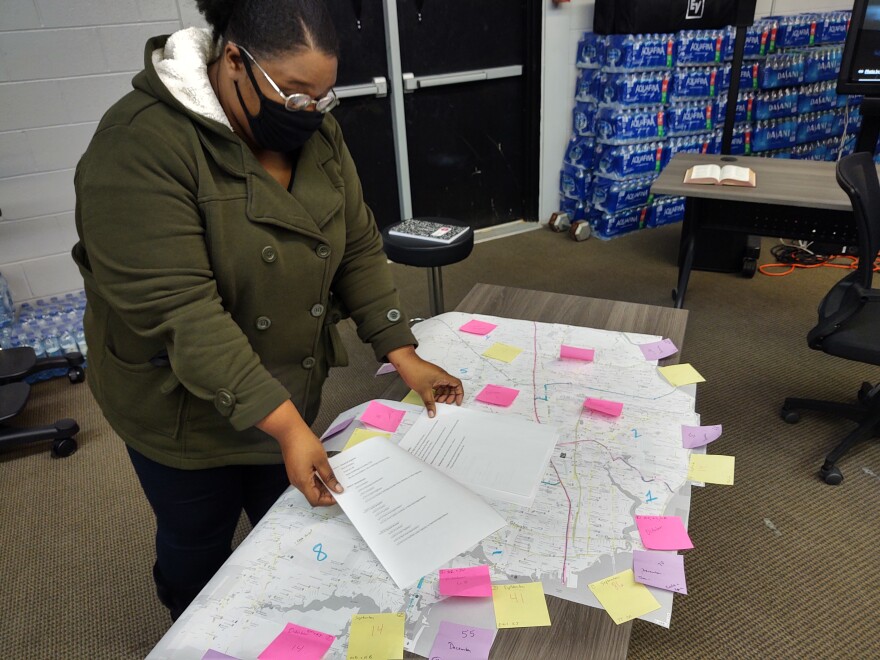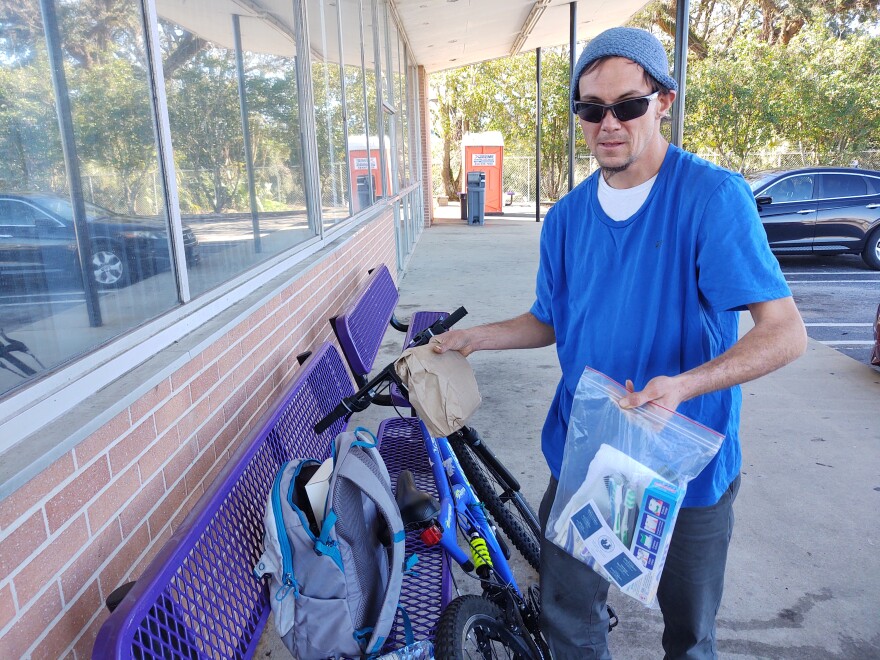The coronavirus pandemic has brought about some operational changes in HUD’s 2021 Point-In-Time survey of individuals who are homeless.
WUWF recently stopped by Opening Doors Northwest Florida to check on its annual count of homeless people in Escambia and Santa Rosa counties.
“The Opening Doors foundation is excellent helping the public, I give them props. Thanks much for helping our public on that one,” said David Kowalchyk.
The 40-year-old struggling songwriter visited the Opening Doors Hub on on New Warrington Rd. Friday to pick up a hygiene packet and a meal. He says fraudulent use of his debit card left him unable to pay his rent. As a result, he’s been homeless for about four months. He’s been forced to take up a second job.
“I have managed to make enough to get a bike, a phone, a book bag, and a couple of extra blankets. I’ll probably have a rental place because I finally got my finances right. I found a roommate. But, this month I’m literally living pretty much in a tent to get by,” he said.
In his current circumstance, Kowalchyk would be classified as an “unsheltered” homeless person, according to Opening Doors PIT Count Coordinator Martika Baker.
“The unsheltered include someone that is literally living on the streets. They could be sleeping in their car,” Baker explained. “They could be in an abandoned building. They could also be in an emergency shelter setting that’s paid for by a nonprofit organization or a church.”
Individuals just released from incarceration or a psychiatric facility also meet the definition of unsheltered.
For 2021, the U.S. Department of Housing and Urban Development (HUD) allowed certain flexibilities in conducting the unsheltered PIT count, with COVID-19 safety guidelines to decrease face-to-face interaction with clients and reduce the number of volunteers assisting with the count.

“What we did is we partnered with two street outreach teams, alongside our entire Opening Doors staff, and those teams were from 90Works and Children’s Home Society,” Baker said of the smaller teams used to conduct the count. “We came up with routes and some hotspot locations where we are aware homeless congregate for meals.”
After a series of successful mini counts in the last quarter of 2020, Opening Doors opted to document the 2021 number of unsheltered individuals in the Escambia and Santa Rosa by conducting blitz counts over a three-hour period, from 9am to noon, over three days last week.
Street outreach teams went to known homeless camps in both counties. Among other locations, Children’s Home Society volunteers counted individuals showing up for meals at Bright Bridge Ministries, formerly Richard’s Memorial.
The team from 90-Works went to the Alfred Washburn Center.
This year, due to COVID, volunteers had to forego detailed demographic surveys in favor of “Observation-Only” data entered into their specially designed Hyperion App.
“They turned on their location services, started doing the surveys where they were collecting basic demographic information; unfortunately, not the name, date of birth and Social Security numbers like we’d normally would do in a short survey,” Baker said. “And, since this was all observational, they didn’t really have to go up to the client, they could just stay in a 6-foot distance away and count as a group.”

Data they were able to collect included gender, race, possible ethnicity, and approximate age, and whether the individual observed was sleeping, panhandling, had a bike, tent or camper. Additionally, volunteers tracked whether persons walked up for meals or arrived in a vehicle. Identifiers for Veterans included tattoos and caps.
“A large amount of our homeless were definitely in the Cervantes/Davis Highway corridor,” declared Baker as she leaned over a large tabletop paper map in the Opening Doors multi-purpose room.
The map, dotted with colored sticky notes, was used for planning. “We also had a lot over here in the Highlands/Saufley Field area,” she added.
Across the room, a large monitor shows the data that was uploaded in real time to the Hyperion App.
“So, you can see this map shows every spot in Escambia and Santa Rosa Counties, where we observed a homeless individual or a group of homeless individuals during the PIT Count,” said Data Reporting Specialist Aaron Jacobs.
“You can see there are certain hotspots. We can zoom in and see that in the downtown area, there were quite a few. There are a lot down here in that area under the interstate.”
This is site under the interstate near downtown Pensacola is the location of a controversial popup homeless camp near Hollice T. Williams Park.
As he continued to navigate the App’s digital map, Jacobs highlights other areas around the Waterfront Rescue Mission and the Alfred Washburn Center.

In their 2020 trial run, the app was free. This year, it cost $3,000, but from Jacobs’ point of view, it’s well worth it.
“It was great this year,” Jacobs proclaimed. “It was even better than last year. It was very easy to customize and put different types of fields in there, so we could adapt to the new situation this year.”
“I think we did well,” concluded PIT Count Coordinator Martika Baker.
“This is unduplicated data right now. But, we have ended up with 574 unique inputs into the app,” she said of their preliminary count of “unsheltered” individuals, which is 200 more than the 374 reported in 2020. “Just in our numbers right now, it looks like a 34 percent increase from last year’s point in time.”
According to Baker, data entered into their Homeless Management Information System (HMIS), show COVID-19 is a factor in the increase in the number of unsheltered homeless, as well as the number of people at risk of becoming homeless.
While the number of “sheltered” homeless people in Escambia and Santa Rosa is still being calculated, last year’s total of 372 is expected to decrease, in part because of COVID-related restrictions on the number of beds available at each shelter.
Checking the 2021 PIT Count in Okaloosa and Walton counties, the Homelessness & Housing Alliance was unable to conduct the traditional unsheltered count due to the pandemic, but is relying on other data collection methods to determine the number of homeless individuals in that region.


